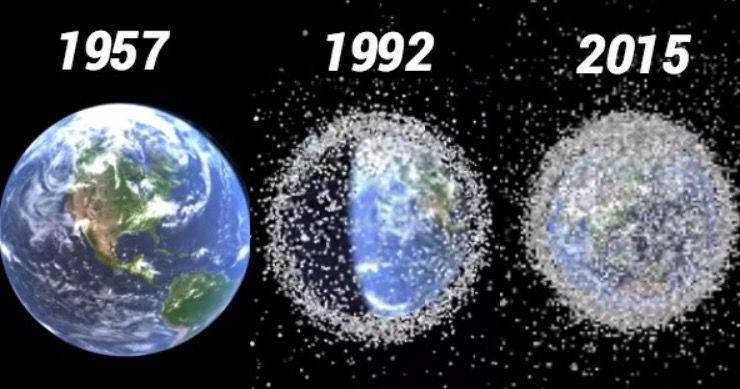Space Junk
Space Junk
This is important! The debris from launch vehicles and satellites is cluttering the space around the Earth to the point that it may make launching new probes and satellites extremely difficult and dangerous. As a matter of fact, space debris poses a risk to the ISS, the International Space Station, which has been moved to avoid a collision sixteen times in the fifteen years it has been up there.
There is approximately 29,000 large pieces of debris (10 cm or more across). Estimates put the mass of debris at 5,500 tons. Most of this junk is in low earth orbit (160 to 2000 kilometers altitude). Anything at 240 kilometers or below suffers drag from the thin atmosphere and eventually falls (usually burning up) from orbital decay. The problem is that many manned missions go into low earth orbit and thus are threatened by debris that could cross a spacecraft's orbit. A hit from anything, even something small (less than 3 centimeters) represents a real threat, especially to an astronaut on EVA. Although a spacesuit is good protection against the dangers of space (heat, cold, vacuum and radiation) it is vulnerable to a collision from even a small piece of debris traveling at 17,000 miles per hour. It didn't help the situation when China recently decided to destroy one of its satellites in orbit, causing thousands of pieces of debris.
Larger debris can be tracked from ground-based locations. Despite the fact that debris as small as 1 cm can be tracked, most junk is unobservable. Everything from visual tracking, radar and FM radio waves is used to track space junk. But, you can imagine the enormity of the situation with so much stuff up there flying around at 17,000 miles per hour. Couple this with the fact that one object falls to earth per day and tons of junk burn up in the atmosphere. It's a zoo up there! Every time NASA launches a probe or satellite, they have to consider the safety factor of launching it into an orbital junkyard.

So, what's being done about it? There are some international protocols established to ensure that stuff launched up into space is designed to fall out of orbit when it's done doing what it was designed to do. The idea here is to have a one-up, one-down plan in place so that the number of things doesn't increase. The way to implement this is to design the satellite with an engine that would allow it to slow down and drop out of orbit when it's no longer needed.
There are some crazy ideas on how to remove space junk. One would be to sweep the stuff up using an unmanned satellite. That could pose a problem if it gets damaged from the very debris it's trying to round up.
I like the space net idea. We'll send up a satellite with big net to snag the junk and then bring it down to Earth.
Another idea is to use a laser to essentially shoot it out of orbit. That smacks of a space weapon. What's to stop some country from shooting a rival's satellites from orbit?
Larger debris is very dangerous. According to the Kessler report (financed by the U.S. Air force), a 1-kilogram object traveling at 10 kilometers per second would smash the crap out of a 1000-kilogram satellite, creating a huge amount of debris. Ouch!
If nothing is done and no new launches are made, the amount of debris will increase (because of collisions) to the critical point, essentially stopping new launches and sending us back to the days before rockets. The only solution to this is for nations to cooperate in preventing more space junk before it's too late.
Thanks for reading.
Bạn đang đọc truyện trên: Truyen247.Pro